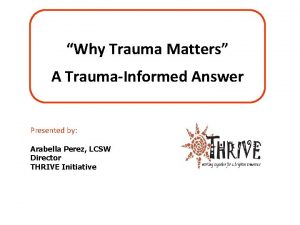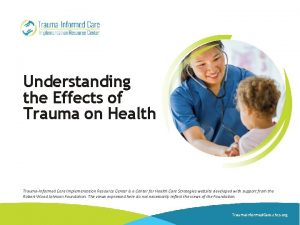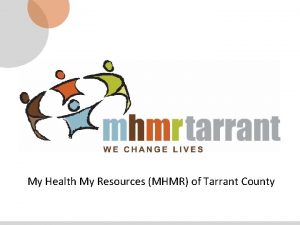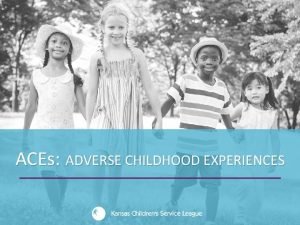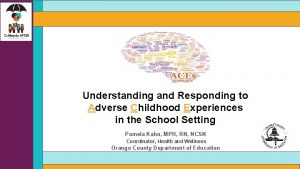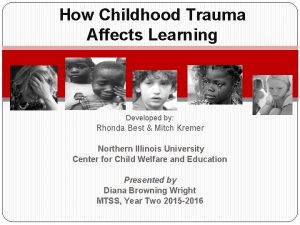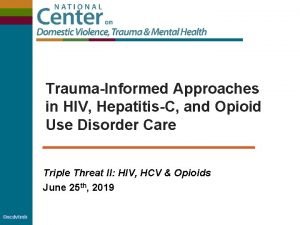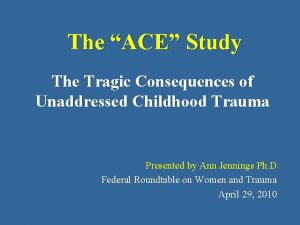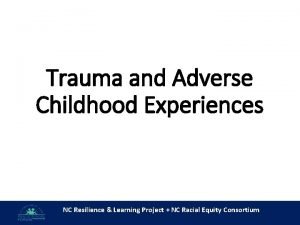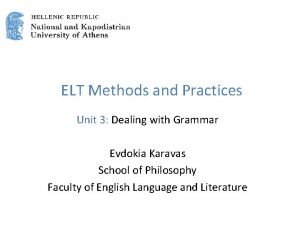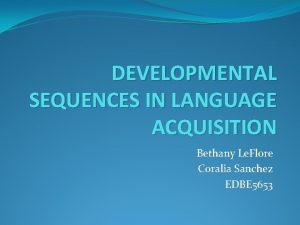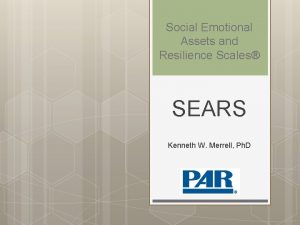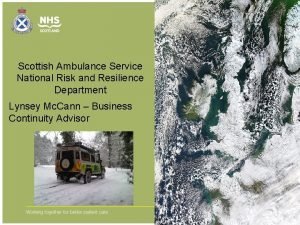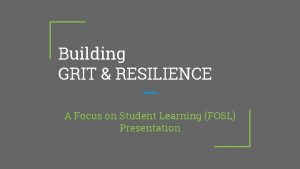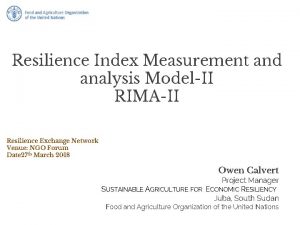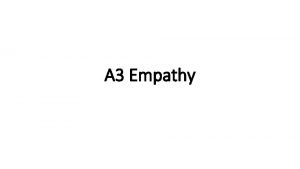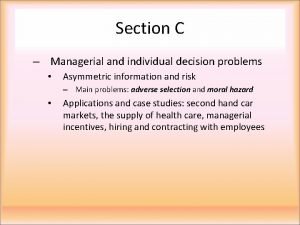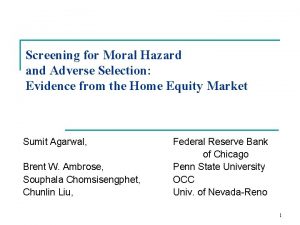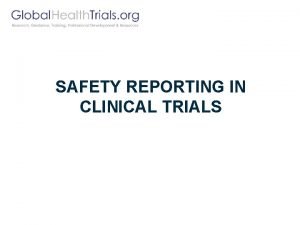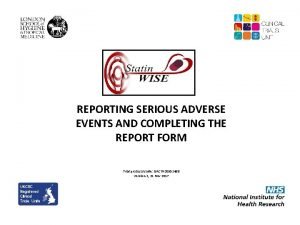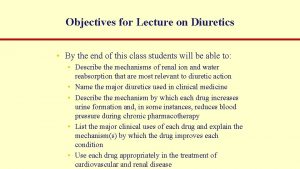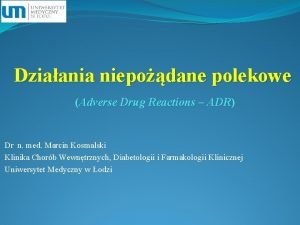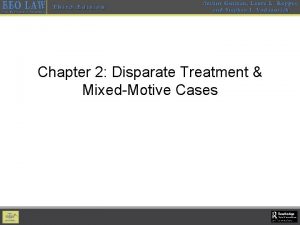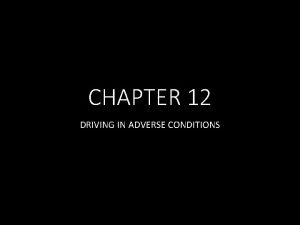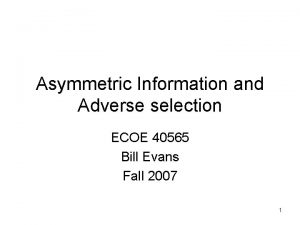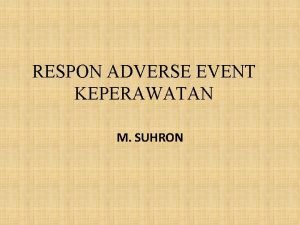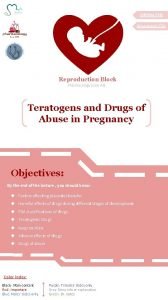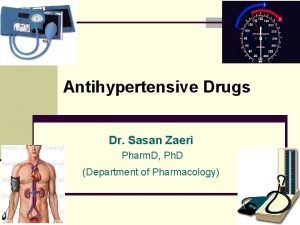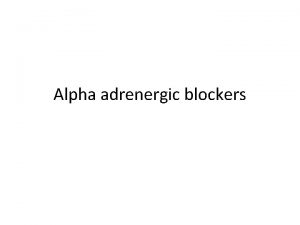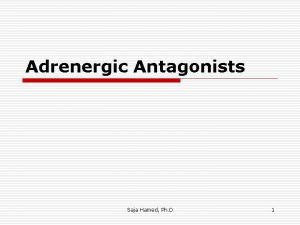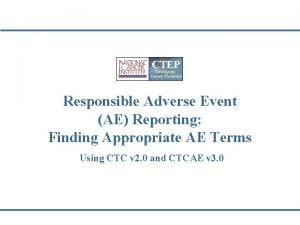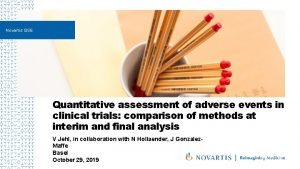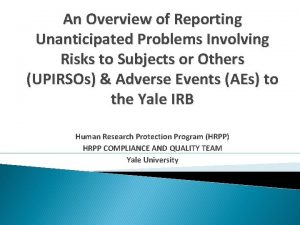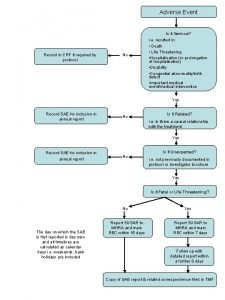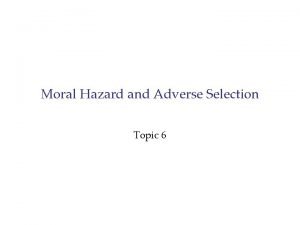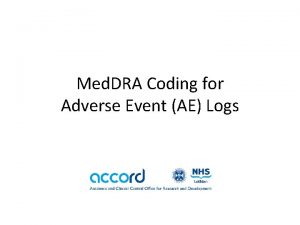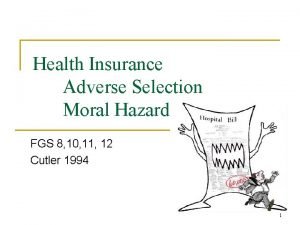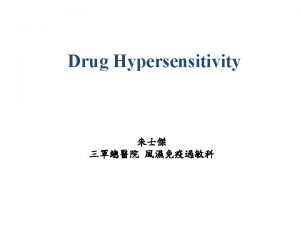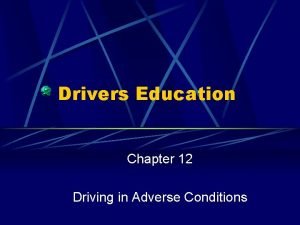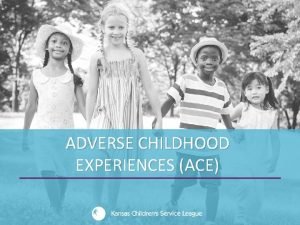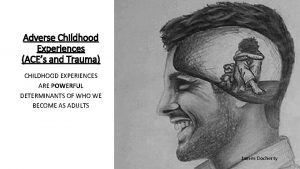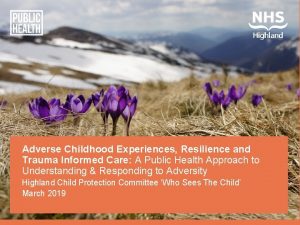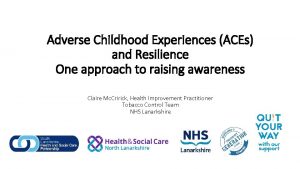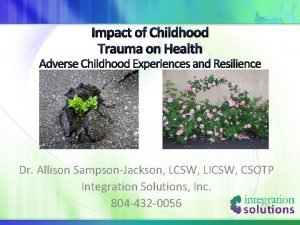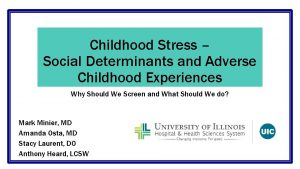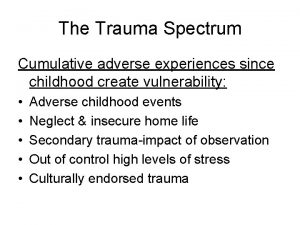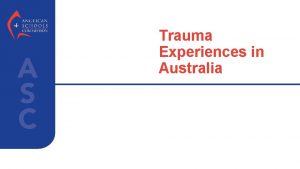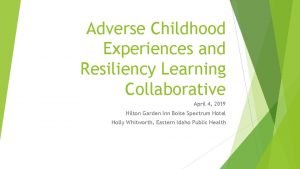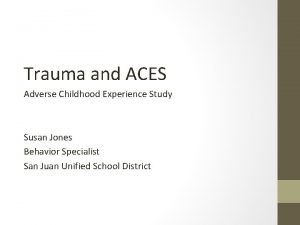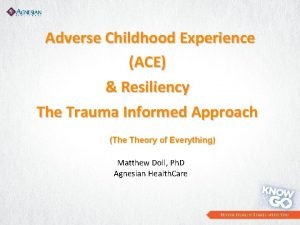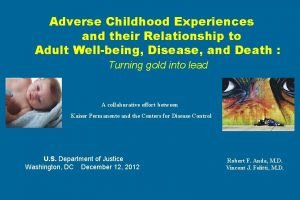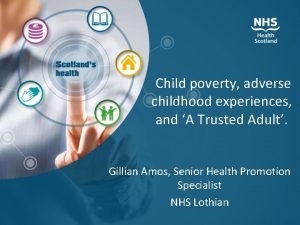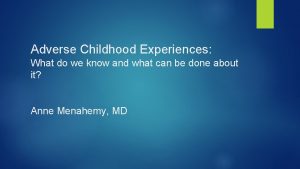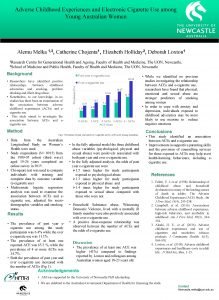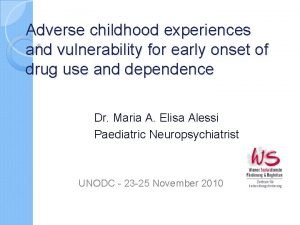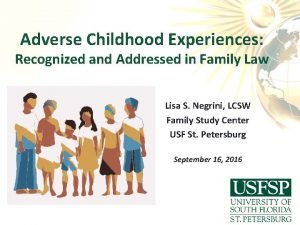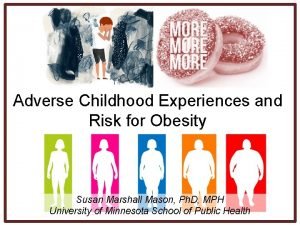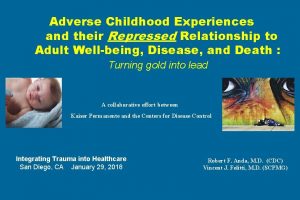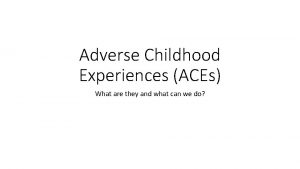Trauma and Adverse Childhood Experiences NC Resilience Learning





























































- Slides: 61

Trauma and Adverse Childhood Experiences NC Resilience & Learning Project + NC Racial Equity Consortium

Study Group XVI Overview Kicked off in October 2015 – Expanding Educational Opportunity in NC Divided work in three committees – Racial Equity, Trauma & Learning, Low Performing Schools 176 committee members; 327 members and guests attended one or more committee meetings. Attendees represent diverse backgrounds and perspectives (teachers, principals, legislators, superintendents, members of local school boards, business leaders, researchers, and other education professionals and advocates) Completed work Summer of 2016 and released final report and recommendations in October 2016. NC Resilience & Learning Project + NC Racial Equity Consortium

What is Trauma? • Trauma may be a response resulting from: • A one-time event OR • A chronic situation • Vicarious experiences that are repeated • Trauma can be the result of a number of categories of events such as: • • • Poverty/homelessness/lack of basic needs Exposure to violence Physical, sexual, or emotional maltreatment Chronic neglect Caregiver substance abuse or mental illness Loss of caregiver (e. g. , incarceration, custody change, death, parents serving overseas) NC Resilience & Learning Project + NC Racial Equity Consortium

What is Trauma? “Trauma is not an event itself, but rather a response to stressful or adverse experiences, particularly during childhood, in which a person’s ability to cope is dramatically undermined” Cole, S. F. , O’Brien, J. G. , Gadd, M. G. , Ristuccia, J. , Wallace, D. L. , Gregory, M. (2005). Helping Traumatized Children Learn. Boston, MA: Massachusetts Advocates for Children, pp. 18. NC Resilience & Learning Project + NC Racial Equity Consortium

What are ACEs? Go to PBWorks Site – Adverse Childhood Experiences • ACEs: Adverse Childhood Experiences • In 1995 -1997, the largest study ever conducted on ACEs was done by the CDC and Kaiser-Permanente in California and included over 17, 000 participants • The ACE Questionnaire includes 10 questions about 10 different adverse childhood experiences https: //www. cdc. gov/violenceprevention/acestudy/about. html NC Resilience & Learning Project + NC Racial Equity Consortium

Lets Take The ACE Quiz For Ourselves http: //www. npr. org/sections/health-shots/2015/03/02/387007941/take-the-ace-quiz-and -learn-what-it-does-and-doesnt-mean https: //www. cdc. gov/violenceprevention/acestudy/about. html NC Resilience & Learning Project + NC Racial Equity Consortium

Impacts of ACEs / Trauma Exposure NC Resilience & Learning Project + NC Racial Equity Consortium

What is the impact of trauma and toxic stress? • Toxic stress is caused by prolonged or pronounced stress that overwhelms children’s skills or support • This causes children to go into “survival mode” or remain in a state of “stress response” • Being in this state on a regular basis actually alters the chemical and neurological events in a child’s brain NC Resilience & Learning Project + NC Racial Equity Consortium

Chemical Reactions in the Brain • When a child experiences toxic stress: • Stress hormones (such as cortisol) are released and remain at high levels • This causes chemically toxic effects on brain regions involved in problem solving and decision-making • This toxic chemical reaction enhances functioning in emotional parts of the brain that respond instinctively to threat NC Resilience & Learning Project + NC Racial Equity Consortium

Brain Development • “Downstairs Brain” – Limbic System that controls: • Arousal • Emotions • The body’s physical response to stress (fight, flight, freeze) • When the “downstairs brain” is continually working to respond to stress and danger, it is hard for a child to switch to using parts of the brain needed for academic learning • “Upstairs Brain” – Prefrontal Cortex that controls functions needed for learning: • • • Ability to think and reason Ability to take in new information Memory Ability to make decisions calmly Ability to focus attention Impulse control Souers, K. & Hall, P. (2016). Fostering Resilient Learners. Alexandria, VA: ASCD. NC Resilience & Learning Project + NC Racial Equity Consortium

Think about a time… • Have you ever been driving and focused on one thought – maybe your grocery list, what to cook for dinner, your first to-do item at work that day – and all of a sudden someone cuts you off or you have to suddenly slam on your brakes? • What does your mind do in that moment? • What does your body do in that moment? • Are you able to easily go back to the task you were originally thinking about? This is how children with trauma may feel ALL the time. NC Resilience & Learning Project + NC Racial Equity Consortium

Fight, Flight, Freeze Response • The limbic system (“downstairs brain”) lets the body know when it is in danger and tells it to respond in one of three ways: • Fight: verbal and physical aggression or defiance • Flight: instinct to run and escape the danger • Freeze: wanting to shut down, withdraw, or become invisible • In normal situations, the limbic system keeps us safe, but for a child with trauma, this can become a constant state of being for them • These three responses are seen in a wide range of behaviors in kids How have you seen the fight, flight, or freeze response in children in your classes? NC Resilience & Learning Project + NC Racial Equity Consortium

What Does This Look Like in Schools? NC Resilience & Learning Project + NC Racial Equity Consortium

Impact of Trauma is Seen in: Learning & Academic Performance Classroom Behavior Relationships – peers/teachers NC Resilience & Learning Project + NC Racial Equity Consortium

Impacts on the Whole School Students impacted by ACEs tend to: • Receive more office/discipline referrals • Have Increased suspension and expulsion rates • Have Lower academic performance – lower test scores, including Reading • Have Higher retention rates • Have Poorer attendance and tardiness rates NC Resilience & Learning Project + NC Racial Equity Consortium

Impacts on the Whole School Students impacted by ACEs tend to: • Have Slowed language development • Be more likely to have Attention problems (ADD/ADHD) • Have Speech delays • Experience Poor verbal memory/recall • Experience a Physical shrinkage of the brain NC Resilience & Learning Project + NC Racial Equity Consortium

Impacts on the Whole School Students impacted by ACEs tend to: • Be at 2 ½ times greater risk to fail a grade. • Score lower on standardized tests. • Have language difficulties. • Be suspended or expelled more often. • Be designated to special education more frequently. • Have poorer health. NC Resilience & Learning Project + NC Racial Equity Consortium

ACEs Videos • https: //www. youtube. com/watch? v=We 2 Bqmj. HN 0 k&list=PL 8 u. X 4 Xr_dk. Jk 8 S 6 GR X 04 u. VJUQGrq. ZZjj. X • https: //www. youtube. com/watch? v=cc. KFkcf. Xx-c • https: //www. youtube. com/watch? v=Wuy. Pu. H 9 oj. CE • https: //www. youtube. com/watch? v=95 ov. IJ 3 ds. Nk&list=PL 6 YEF 9 Pf. Ej. IC 1 A 7 Joku. Xk 2 CFVnh. FTHtf&index=3 NC Resilience & Learning Project + NC Racial Equity Consortium

NC Resilience & Learning Project: How it will work • Two key components: • Professional Development: Ø Training for the entire staff school-wide (should include ANY school staff who interact with students) Ø More in-depth training for the Resilience Team • Resilience Team: Ø A team within each school that will meet bi-weekly throughout the year to identify areas of urgency and work through a focused action planning process to create strategies that will make your school trauma-sensitive NC Resilience & Learning Project + NC Racial Equity Consortium

How we can start: Shifting our view • Promote WHOLE school WHOLE child approach that is a total culture shift within the school – looking at a child thinking “What happened to you? ” instead of “What is wrong with you? ” Traditional View Trauma-informed View Impulsive Difficulty regulating emotions Aggressive/Defiant Trauma response triggered, trying to gain control and find safety Withdrawn/”unmotivated” Afraid, overwhelmed, world is a dangerous place Over-reacting Seeking to get needs met ADHD Lacking necessary skills Reaction: STUDENT NEEDS TO BE PUNISHED Reaction: STUDENT NEEDS SKILLS AND SUPPORT NC Resilience & Learning Project + NC Racial Equity Consortium

Do Trauma-Sensitive Schools Matter? NC Resilience & Learning Project + NC Racial Equity Consortium

Early Findings on Trauma. Sensitive Schools Decrease in: • Student depression symptoms • Behavioral outcomes after 1 year: • Suspension rates by 30 -90% • Office referral rates by 20 -44% • Incidents of physical aggression by 43% • Behavioral outcomes after 5 years: • Suspension rates by 95% Dorado, et al (2016) & Stevens (2012) NC Resilience & Learning Project + NC Racial Equity Consortium

Early Findings on Trauma. Sensitive Schools Increase in: • Student self-esteem • Academic outcomes: • • Students’ ability to learn by 28% Student time on task while in class by 27% School attendance rate by 34% Test scores Dorado, et al (2016) & Stevens (2012) NC Resilience & Learning Project + NC Racial Equity Consortium

Racial Equity in NC Public Schools: Where Are We Now NC Resilience & Learning Project + NC Racial Equity Consortium

Qualifying the Meaning of Equity NC Resilience & Learning Project + NC Racial Equity Consortium 27

Understanding Equity 3/3/2021 NC Resilience & Learning Project + NC Racial Equity Consortium The Common Good: Community Conversations 28

Race Still Matters NC Resilience & Learning Project + NC Racial Equity Consortium

From Charlotte to Charlottesville NC Resilience & Learning Project + NC Racial Equity Consortium

NC Resilience & Learning Project + NC Racial Equity Consortium

NC Resilience & Learning Project + NC Racial Equity Consortium

Qualifying Definitions • • • Race – socially-constructed classification of humans according to some physical features (eg; skin color, hair texture, body type, etc. ). Racism – (1) any individual or systemic belief, attitude, action or inaction, which grants or denies groups access and/or opportunity based on their race. (2) a pattern of social institutions — such as governmental organizations, schools, banks, and courts of law — giving inequitable treatment to a group of people based on their race. Implicit Racial Bias - refers to the attitudes or stereotypes based on patterns and associations about a racial group that affect our understanding, actions, and decisions in an unconscious manner. Disproportionality – disproportionate representation – over or under - of a given population. (eg; race, ethnicity, Socioeconomic Status, nationality, Limited English Proficiency, gender, etc. ) Racial Disparity – noticeably unjust or unfair outcomes based on race when individuals or groups are similarly-situated Disparate Impact - a facially neutral policy or practice has an unjustifiable effect of discriminating on the basis of race, color, national origin, gender, or disability. NC Resilience & Learning Project + NC Racial Equity Consortium

Racial Equity • • Resegregation (Public & Charter) Opportunity Gap Discipline Disparities Overrepresentation in Special Education Access to Rigorous Courses and Programs Diversity in Teaching Culturally Responsive Pedagogy Do the national trends of racial inequity persist in North Carolina Public Schools? NC Resilience & Learning Project + NC Racial Equity Consortium

Resegregation • Brown v. Board of Education (1954), North Carolina has several districts that have since resegregated • Abandonment of desegregation efforts in favor of “neighborhood school” models has once again made schools more racially identifiable, due in part to residential segregation • For residents living in majority Hispanic and African American census blocks, the chance of their children attending racially-identifiable, high poverty, or lowperforming schools is dramatically higher than for those in majority white census block NC Resilience & Learning Project + NC Racial Equity Consortium

Resegregation • Over the past two decades, the share of Black and Hispanic students attending majority-minority and intensely-segregated schools statewide has grown significantly. • Resegregation has appeared in other counties as well, including Guilford, Forsyth, Pitt, Halifax, and Harnett • North Carolina charters are increasing the extent to which the overall system of public education in the state is racially identifiable as well. • Roughly two-thirds of all charter schools in the state are either disproportionately white or disproportionately students of color. NC Resilience & Learning Project + NC Racial Equity Consortium

Trend in Black Student Segregation Source: Segregation Again: North Carolina's Transition From Leading Desegregation to then Accepting Segregation NC Resilience & Learning Project + NC Racial Equity Consortium

Trend in Latino Student Segregation Source: Segregation Again: North Carolina's Transition From Leading Desegregation to then Accepting Segregation NC Resilience & Learning Project + NC Racial Equity Consortium

Discipline Disparities • Students of color in North Carolina schools have significantly higher rates of both short- and long-term suspensions than their white counterparts. • The state has lowered the overall rates of suspension and expulsions over the past several years. What has not changed, however, is the disproportionate representation of students of color in disciplinary actions • Black students in particular are as much as four-times as likely to receive short-term suspensions as their white counterparts, with similar gaps in long-term suspension data. • American Indians are suspended at rate three-and-a-halftimes more. NC Resilience & Learning Project + NC Racial Equity Consortium

Rate of Short Term Suspensions by Race Source: North Carolina Department of Public Instruction NC Resilience & Learning Project + NC Racial Equity Consortium

Rate of Long Term Suspension by Race Source: North Carolina Department of Public Instruction NC Resilience & Learning Project + NC Racial Equity Consortium

Subjective vs. Objective Offenses NC Resilience & Learning Project + NC Racial Equity Consortium

NC Resilience & Learning Project + NC Racial Equity Consortium

NC Resilience & Learning Project + NC Racial Equity Consortium

Opportunity Gap • In nearly every educational metric, from cohort graduation rates to college and career readiness, the majority of students of color in North Carolina underperform their white counterparts. • The trend holds even when one controls for economic disadvantage, exceptional children’s status, and limited English proficiency. This is commonly called the “achievement gap, ” but is perhaps better termed an “opportunity gap. ” • A student is at a decided disadvantage if he lives in poverty, lacks stable housing or adequate healthcare, experiences food insecurity, is exposed to adverse childhood experiences, has limited english proficiency, or is an undocumented immigrant. Students of color are overrepresented in these categories, all of which have deleterious effects on academic achievement NC Resilience & Learning Project + NC Racial Equity Consortium

Overrepresentation in Special Education • In North Carolina, all racial subgroups remain relatively proportionately represented, with the exception of African Americans, who make up 26 percent of all public schools students yet comprise 32 percent of all school-aged children with disabilities. • Specific areas where they are most overrepresented are: intellectual disability (45%), emotional disturbance (44%), developmental delay (34%), and specific learning disability (32%). • Research in this area suggests that overrepresentation in these categories belies misdiagnosis rooted in cultural bias and misunderstanding. NC Resilience & Learning Project + NC Racial Equity Consortium

Overrepresentation in Special Education NC Resilience & Learning Project + NC Racial Equity Consortium

Access to Rigorous Courses & Programs • Students of color are underrepresented in the most rigorous courses and programs offered in North Carolina schools, including Advanced Placement (AP), International Baccalaureate (IB), and Academically or Intellectually Gifted (AIG) • But a concerted effort has been made to increase AP subgroup enrollment and test-taking in North Carolina. Student participation in AP courses among American Indian students increased by 45 percent last year • In AIG identification, disparities persist, with Black and Hispanic students the most dramatically underidentified groups, both around 5 percent NC Resilience & Learning Project + NC Racial Equity Consortium

Racial Distribution of Academically & Intellectually Gifted Students Source: North Carolina Department of Public Instruction NC Resilience & Learning Project + NC Racial Equity Consortium

AP Racial Participation Rates and Gains NC Resilience & Learning Project + NC Racial Equity Consortium

Diversity in Teaching • In North Carolina, the vast majority of the teaching force is white (84%). • This is a tremendous mismatch with an increasingly diverse student population that is half non-white. For the majority of teachers in the state it is likely that they will teach students who do not come from the same racial or ethnic background. • Research has indicated that having teachers of color reduces the likelihood of suspension for students of color, leads to increased achievement, and increases identification as AIG. NC Resilience & Learning Project + NC Racial Equity Consortium

*Total is greater than 100 due to those identifying ethnically as Hispanic Source: Center for American Progress NC Resilience & Learning Project + NC Racial Equity Consortium

Culturally Responsive Pedagogy • Teachers must be able to relate to the students they serve. Whatever their background, teachers need to understand their students both as individuals and as representatives of their communities. • Unfortunately, recent North Carolina Teacher Effectiveness ratings for teachers instructing students of color have been dismal • Approaches to teaching that honor students’ cultural customs and traditions have been shown to increase achievement. • Underpinning many of the data disparities related to culturally-responsive pedagogy is the presence of implicit racial bias. NC Resilience & Learning Project + NC Racial Equity Consortium

NC Resilience & Learning Project + NC Racial Equity Consortium

NC Racial Equity Consortium • Vision Statement: We are a statewide collaborative that will eliminate race as the predictor of educational outcomes for students in North Carolina. • Comprised of school districts, community advocates, education researchers and consultants. • Fee-based membership • Work collaboratively to dismantle systems and structures that keep racial achievements gaps in place across NC schools. • Four main areas of intervention: (1) Strategic Planning, (2) Community Engagement, (3) Convening and (4) Professional Development 3/3/2021 NC Resilience & Learning Project + NC Racial Equity Consortium Public School Forum Membership Meeting 55

3/3/2021 NC Resilience & Learning Project + NC Racial Equity Consortium Public School Forum Membership Meeting 56

Strategic Planning • Formation of a Design Team or Advisory Board (met 4 x) • • • 6 District Equity Officers 2 School Board Members 1 Superintendent 1 Education Attorney Several researchers and consultants • Building a framework for racial equity work in NC 3/3/2021 NC Resilience & Learning Project + NC Racial Equity Consortium Public School Forum Membership Meeting 57

Community Engagement • Assessing racial climate in communities utilizing surveys • Bringing awareness to the racial inequities in the school system (i. e. hosting town halls and listening sessions) • Organizing stakeholders using collective voice • Using feedback to guide the Consortium and hold it accountable to communities. 3/3/2021 NC Resilience & Learning Project + NC Racial Equity Consortium Public School Forum Membership Meeting 58

Convening • Holding an annual Racial Equity Symposium, featuring premiere speakers, sessions and workshops explicating dealing with the intersection of race and education. • In addition, mini-conferences that allow educators to collaborate peer-to-peer across districts while focused on fixing racial disparities in outcomes. (i. e. superintendents, admins, teachers, board members, students) 3/3/2021 NC Resilience & Learning Project + NC Racial Equity Consortium Public School Forum Membership Meeting 59

Professional Development • Providing access to research and best practices in the area of racial equity • A clearing house for expert trainers and consultants that work more intensely with districts and schools as service providers • Information sharing and resource hub for those looking to learn more. 3/3/2021 NC Resilience & Learning Project + NC Racial Equity Consortium Public School Forum Membership Meeting 60

Considering Racial Equity + Trauma NC Resilience & Learning Project + NC Racial Equity Consortium

How do we see all of this through a racial equity lens? As we think about trauma impacts and traumainformed practices, also consider the issues with a racial equity lens. • Disproportionality of trauma by race • How do we incorporate equity into the conversation about trauma and resiliency? • As we move forward in looking at areas of urgencies and strategizing, how do we ensure that we are creating trauma -sensitive practices that are also racially equitable? NC Resilience & Learning Project + NC Racial Equity Consortium

Two Strikes: Race and the Disciplining of Young Students (Ebenhardt & Okonfura, 2015) • 57 K-12 Teachers • Teachers were given an adapted school referral records of an middle school student • The identical records were manipulated by using stereotypical black names (Darnel or Deshawn) vs. white names (Greg or Jake). • After reading infractions, they were asked to rate how irritated they were and how severely the student should be punished. • After the second round, black students were rated more severely. NC Resilience & Learning Project + NC Racial Equity Consortium 63
 Adverse childhood experiences study
Adverse childhood experiences study Adverse childhood experiences study
Adverse childhood experiences study Adverse childhood experiences study
Adverse childhood experiences study Adverse childhood experiences powerpoint
Adverse childhood experiences powerpoint What are adverse childhood experiences
What are adverse childhood experiences Early and middle childhood
Early and middle childhood Childhood trauma discussion questions
Childhood trauma discussion questions What is childhood trauma
What is childhood trauma Childhood trauma test
Childhood trauma test Nc resilience and learning project
Nc resilience and learning project Meaningful learning experiences examples
Meaningful learning experiences examples Cuadro comparativo de e-learning
Cuadro comparativo de e-learning Language learning in early childhood
Language learning in early childhood A vygotskian classroom promotes ________.
A vygotskian classroom promotes ________. Sears rating scale
Sears rating scale National risk and resilience unit scotland
National risk and resilience unit scotland Firefighter pqa
Firefighter pqa Building grit in students
Building grit in students Resilience index measurement and analysis
Resilience index measurement and analysis Robert vischer empathy theory advantages
Robert vischer empathy theory advantages Adverse reaction definition
Adverse reaction definition Sentinel event report example
Sentinel event report example Adverse selection
Adverse selection Adverse selection
Adverse selection Adverse reaction definition
Adverse reaction definition Adverse reaction definition
Adverse reaction definition Adverse events in hospital
Adverse events in hospital Ir adverse event
Ir adverse event Adverse events in hospital
Adverse events in hospital Adverse selektion
Adverse selektion Acetaminophen mechanism
Acetaminophen mechanism Loop diuretics adverse effects
Loop diuretics adverse effects Paracetamol dose per kg
Paracetamol dose per kg Vildagliptin renal dose adjustment
Vildagliptin renal dose adjustment Adverse selection
Adverse selection Adr adverse drug reaction
Adr adverse drug reaction Furosemide side effects
Furosemide side effects Classification of diuretics
Classification of diuretics Hayanil side effects
Hayanil side effects Adverse treatment
Adverse treatment To give yourself more time for the ipde process at night
To give yourself more time for the ipde process at night Chapter 12 driving in adverse conditions
Chapter 12 driving in adverse conditions Adverse selection
Adverse selection Adverse event adalah
Adverse event adalah Drugs that do not cross the placenta mnemonic
Drugs that do not cross the placenta mnemonic Adverse effect of alpha blockers
Adverse effect of alpha blockers Moa of alpha adrenergic blockers
Moa of alpha adrenergic blockers Alpha blocker
Alpha blocker Alpha-adrenergic antagonist
Alpha-adrenergic antagonist Adverse yaw
Adverse yaw Adverse event
Adverse event Novartis adverse event reporting
Novartis adverse event reporting Adverse
Adverse Adverse yaw
Adverse yaw Unanticipated problem vs adverse event
Unanticipated problem vs adverse event Adverse event crf
Adverse event crf Adverse selection
Adverse selection Adverse event log
Adverse event log What is adverse selection
What is adverse selection Definition of adverse event
Definition of adverse event Driving in adverse conditions
Driving in adverse conditions When your headlights shine into fog, *
When your headlights shine into fog, *
